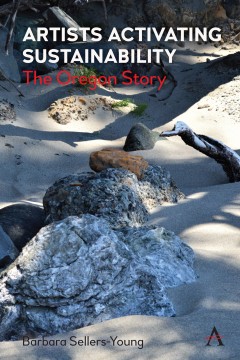Artists Activating Sustainability
The Oregon Story
By Barbara Sellers-Young
Other Formats Available:
- About This Book
- Reviews
- Author Information
- Series
- Table of Contents
- Links
- Podcasts
About This Book
Artists often talk of a sense of community, of being in a place that engages their creativity in a cultural history that is deeply tied to and inseparable from their local environment. The phrase ‘community art’ emphasizes a collaboration between the artist and community; it is practised where the artist and the neighbourhood intersect. Projects most often take place as a means of revitalizing a community or providing an opportunity for community members to engage in a creative process. Increasingly, this has become a national and international movement in which sustainability of the identity of the community, the individuals within it and the environment are at the core of the project. This project engages the conception of art evolved in the ethos of community as its basic framework but considers it from a situationally historic perspective against the backdrop of the diverse landscape of Oregon. As such it considers the role of nature, individual and community identity in the development of arts projects that ultimately become associated with a community’s cultural and social milieu.
Oregon is known for its unique landscape that moves from the high deserts of eastern Oregon through the former volcanoes of the Cascade Range, the breadth of the Willamette River Valley, Coast Range and finally the Pacific coast from Astoria to Brookings. Oregon has a long history of environmental planning. In 1899, the Oregon legislature declared 30 miles of Oregon beach as a public highway from the Columbia River to the south line of Clatsop County. In 1913, they declared the entire coast a public highway. Throughout the 20th century, the Oregon legislature and communities throughout Oregon have placed an emphasis on land use from the role of the timber, fishing and mining industries to the planning necessary for cities and towns. This manuscript considers the combination of people and social cultural ethos that were influential in the development of specific literary, visual and performing arts groups across Oregon’s diverse landscape. Artists Activating Sustainability: The Oregon Story examines the way in which the arts within specific communities, against the background of landscape and history, reveal concepts of sustainability that help us broaden our knowledge of what is needed to create a sustainable world. As such, each chapter considers the themes of participation, agency and empowerment through the lens of land, history and individual initiative.
Reviews
Sellers-Young has provided an insightful text into the specific relationships between places and practices. By looking into the deep history of how the bioregions of Oregon developed geologically, in relationship to human cultures which have called them home, and up to the present-day work of contemporary arts engaged with the strata of these histories, this book highlights how these specific entanglements shape the way artists work and the way art works on society —Ian Garrett, Associate Professor, Department of Theatre and Performance, School of the Arts, Media, Performance & DesignYork University, Canada.
Barbara Sellers-Young’s timely, elegant and detailed portrait of the artistic soul of the place we now call Oregon attests to the generative, sustaining power of artistic practice in diverse communities. Like the waterways that nourish the rich ecological diversity of the region, Artists Activating Sustainability maps the artistic creativity, collaboration and activism that have shaped and influenced the wider Pacific Northwest. Artists become catalysts of a just and sustainable future, the book argues, as they celebrate, document, provoke and help heal communities — Theresa J. May, Artistic Director, Earth Matters on Stage/ Professor, University of Oregon, USA.
Artists Activating Sustainability focuses on the embodied relationship between the landscape, the artists, and their artistic practice as well as how the artists’ engagement activates sustainability in the state of Oregon. By investigating arts and sustainability through the ethos of communities in Oregon —– the landscape, community identity, and the artists’ experiences in forming that identity —– it becomes possible to reflect on and recognize the broader issues that make life sustainable and re-engage a purposeful, environmentally conscious relationship with our community and our world— Kin-Yan Szeto, Professor of Theatre and Dance, Appalachian State University, USA.
Author Information
Barbara Sellers-Young is a performance studies scholar who has taught and held academic administrative positions in United States, Canada, England, Australia and China. Her research on the embodiment of culture has been published in three single- authored books and six edited volumes.
Series
Table of Contents
Acknowledgments; List of Figures xi Introduction: Art, Environment and Metaphor ;1. Environmental Activism, Arts and the Land of Eden,Landscape One: High Desert Basin and Range; 2. The Murals of Vale: Gateway to Oregon; 3. Ontario: The Legacy of Kanriye Fujima 61 Landscape Two: Columbia Gorge and Plateau; 4. James Lavadour and Crow’s Shadow Institute of the Arts, Landscape Three: Cascade Range; 5. Hunter Noack: In a Landscape, Landscape Four: The Willamette Valley; 6. Portland’s Elisabeth Jones Art Center and Signal Fire; 7. Willamette Valley’s Sanctuary Stage; 8. Salem’s Gaiety Hollow: Lord and Schryver Landscape Architects and the Conservancy; 9. Eugene and the Oregon Country Fair; Landscape Five: Rogue River Valley; 10. Ashland: Angus Bowmer and the Oregon Shakespeare Festival, Landscape Six: Oregon Coast and Coast Range 185 11. Astoria’s Fisher Poets; 12. Sitka Center for Art and Ecology; 13. Bandon’s Washed Ashore: Art to Save the Sea; 14. Climate Change, Sustainability and Artists in the Land of Eden; Index
Links
Stay Updated
Information
Latest Tweets



